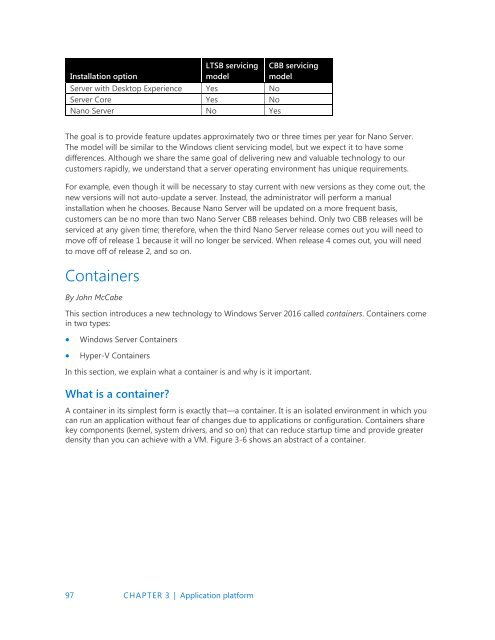Introducing
IntroducingWindowsServer2016_ebook
IntroducingWindowsServer2016_ebook
Create successful ePaper yourself
Turn your PDF publications into a flip-book with our unique Google optimized e-Paper software.
Installation option<br />
LTSB servicing<br />
model<br />
Server with Desktop Experience Yes No<br />
Server Core Yes No<br />
Nano Server No Yes<br />
CBB servicing<br />
model<br />
The goal is to provide feature updates approximately two or three times per year for Nano Server.<br />
The model will be similar to the Windows client servicing model, but we expect it to have some<br />
differences. Although we share the same goal of delivering new and valuable technology to our<br />
customers rapidly, we understand that a server operating environment has unique requirements.<br />
For example, even though it will be necessary to stay current with new versions as they come out, the<br />
new versions will not auto-update a server. Instead, the administrator will perform a manual<br />
installation when he chooses. Because Nano Server will be updated on a more frequent basis,<br />
customers can be no more than two Nano Server CBB releases behind. Only two CBB releases will be<br />
serviced at any given time; therefore, when the third Nano Server release comes out you will need to<br />
move off of release 1 because it will no longer be serviced. When release 4 comes out, you will need<br />
to move off of release 2, and so on.<br />
Containers<br />
By John McCabe<br />
This section introduces a new technology to Windows Server 2016 called containers. Containers come<br />
in two types:<br />
<br />
<br />
Windows Server Containers<br />
Hyper-V Containers<br />
In this section, we explain what a container is and why is it important.<br />
What is a container?<br />
A container in its simplest form is exactly that—a container. It is an isolated environment in which you<br />
can run an application without fear of changes due to applications or configuration. Containers share<br />
key components (kernel, system drivers, and so on) that can reduce startup time and provide greater<br />
density than you can achieve with a VM. Figure 3-6 shows an abstract of a container.<br />
97 CHAPTER 3 | Application platform


